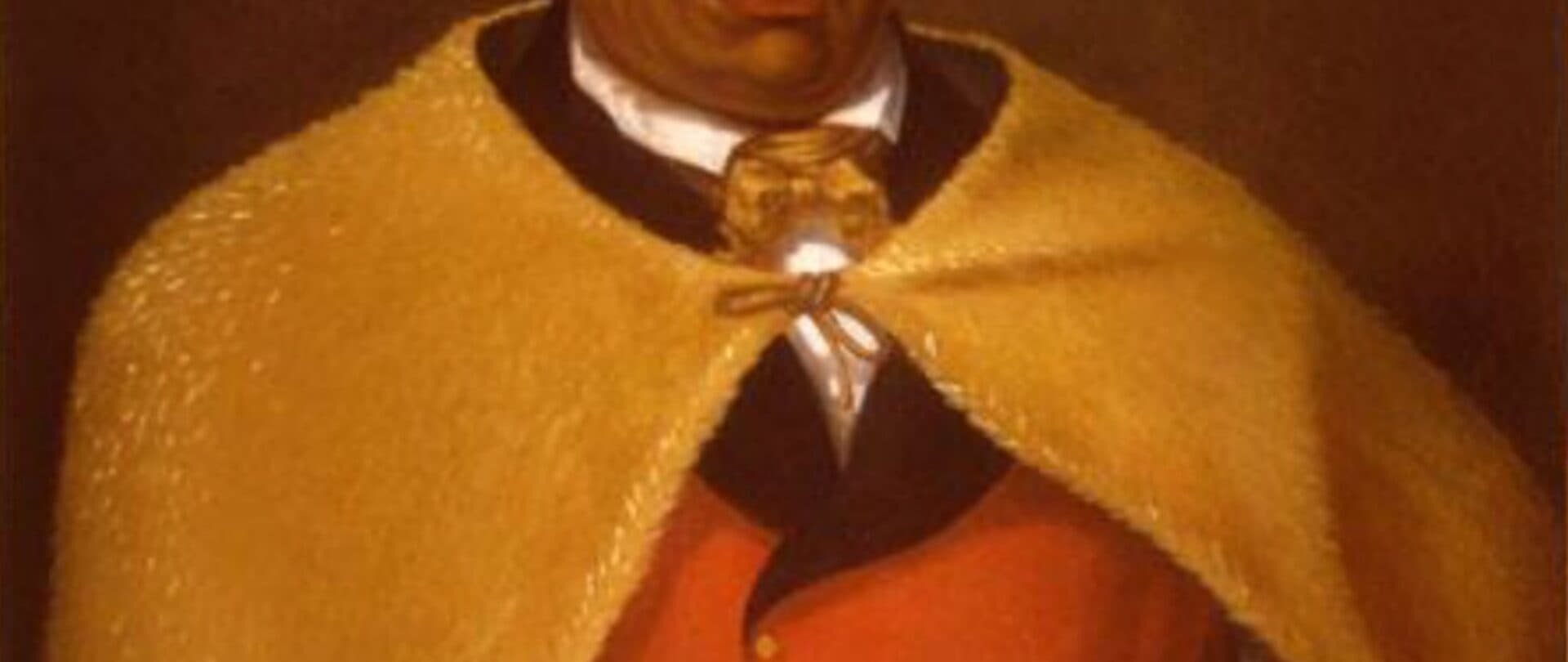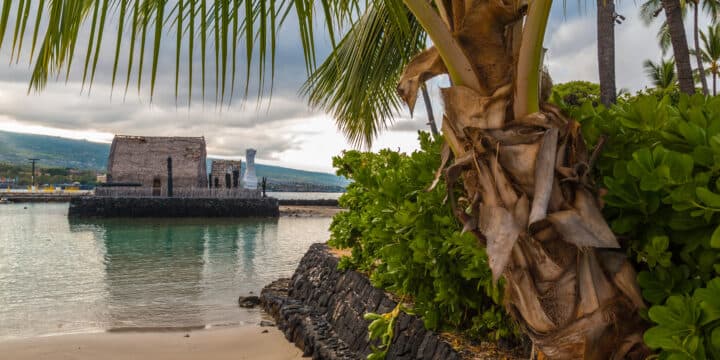Royal Sites
In the footsteps of Kamehameha the Great
BY Krystal Kakimoto
Few places in the world allow you to walk in the footsteps of kings, viewing the same horizons as they did. Across Hawai‘i Island, there are numerous sites important to the life of King Kamehameha the Great, the first ruler of the Kingdom of Hawai‘i. Travel back in time on this tour of sites that shaped the life of this great man.
Naha Stone
Born in North Kohala into a royal family, a comet passed through the sky around the time of Pai‘ea’s birth, later known as Kamehameha. This comet foretold the birth of a great leader, and to protect the infant, his family secreted him away to Waipi‘ʻo for the first five years of his life. Later, he returned to the royal court of his uncle, Kalani‘ ōpu‘u, where he studied warfare, religion and the community's oral history. As the young boy grew, so did his strength, and he tried multiple times to flip the legendary Naha stone.
Lore says this stone was originally located along the Wailua River on Kaua‘i’s eastern coast. The volcanic stone, which weighs about three tons, was shipped to Hawaiʻi Island sometime in the 12th century by Chief Makali‘inuikuakawaiea via a double-hulled canoe. Infant boys were sat upon the stone, and if they did not cry, this proved their legitimacy within the ruling Naha rank. However, if the infant cried, they would be relegated to the rank of a commoner. It was also said that if one could overturn this huge stone, one could unify all the islands. On his third attempt, Kamehameha successfully overturned the stone, paving the way for his future success in unifying the island chain.
The Naha Stone is displayed in front of the Hilo Public Library today. In 1952, this site was chosen as the new site of the Naha Stone because it was also the site of a former heiau (temple). The entrance to the heiau is marked by the Pinao Stone, a stone from the original heiau that sits beside the Naha Stone.
Naha Stone; 300 Waiānuenue Avenue, Hilo.
Pu‘ukohalā Heiau
When Kamehameha was a young man, his uncle Kalani‘ōpu‘u, the ali‘i nui (supreme ruler) of Hawai‘i Island, passed away. He named his son Kīwala‘ō king of Hawai‘i Island, and he gave his nephew, Kamehameha, the task of guarding Kūkā‘ilimoku, the God of War. Following Kalani‘ōpu‘u’s death, the cousins set off in a series of battles to control the island. Eventually, Kamehameha succeeded and set on his course to gain control of the remaining islands.
On the recommendation of Kāpoūkahi, a prophet from the island of Kaua‘i, the prophet told Kamehameha’s aunt that if he rebuilt the heiau at Pu‘ukohalā and dedicated it to Kūkā‘ilimoku, he would be able to conquer all the islands. According to Hawaiian historian and scholar Samuel Kamakau, no one was allowed to be absent from the work to restore the heiau, except for women. For a year, thousands of men camped along the hillside to work on its construction, with even Kamehameha laboring to move lava stones via a human chain that spanned 25 miles. The massive heiau was ultimately completed and measured about 224 by 100 feet. Upon its completion, the area served as a critical location for Kamehameha, where he would hold daily rituals, dedicate offerings and sacrifices and have oracles receive messages from the gods.
Today, a visitor center operated by the National Park Services is located on the site. There is a half-mile loop trail that takes visitors around the grounds, and you can still see the heiau constructed by Kamehameha, the ruins of Mailekini heiau, which was constructed in the 1500s, and the homestead of John Young, a stranded British sailor who became a valuable aid to Kamehameha.
Pu‘ukohalā Heiau; 62-3601 Kawaihae Road, Kawaihae; open daily from 7:30 a.m. to 5:00 p.m.; nps.gov/puhe/index.htm.
Waiānuenue Falls
Often overlooked throughout the life of Kamehameha is Waiānuenue Falls, more commonly known as Rainbow Falls. In 1768, when Kamehameha was about 32 years of age, his father, Keōua, passed away. His name translates to “the rain cloud” and was given to him by his subjects because of his generosity, which rained down upon all. He became a chief of the Kohala and Kona districts, and while not a ruling chief, he still played a vital role in courtly life. After his death, legend tells that Kamehameha prepared the bones of his father in accordance with Hawaiian customs and buried the bones in the cave behind the waterfall.
Today, you cannot access the caves but can view Waiānuenue Falls. Visible from the parking lot, the width of the falls is one of the major draws for visitors. During the rainy seasons, the falls measure about 100 feet in width, making it one of the widest falls in the state. Some opt to view the falls from the parking lot, while others take the quick, fifteen-minute walk along the 0.1-mile, out-and-back hike for an additional view of the waterfall.
Rainbow Falls at the Wailuku River State Park; 2-198 Rainbow Drive, Hilo; open daily during daylight hours; dlnr.hawaii.gov/dsp/parks/hawaii/wailuku-river-state-park/
Pu‘uhonua o Hōnaunau
Located on the island's western side, Pu‘uhonua o Hōnaunau served as a spiritual sanctuary where Hawaiians who broke kapu (ancient Hawaiian law) could avoid death by fleeing to a pu‘uhonua or place of refuge. Once within the refuge, the fleeing party would perform a ceremony of absolution and then be allowed to return to society. The Puʻuhonua o Hōnaunau sits within a 180-acre lot and is home to the Great Wall, which stands 12 feet tall with fierce-looking kiʻi (wooden statues of Hawaiian Gods) who guard Hale o Keawe Heiau, a sacred temple that housed the bones of 23 ali‘i (chiefs) including Kalani‘ōpu‘u and the son of Kamehameha. Near pu‘uhonua are royal grounds that include the Keōua Stone, which marks the favorite resting place of Kamehameha’s father.
Visitors to the grounds can take a self-guided tour with a map provided by the National Park Service. Although some areas of the park are open to visitors, the space remains sacred, so it is recommended that visitors tread lightly, stay on the path and only take photos.
Pu‘uhonua o Hōnaunau; Highway 160, Hōnaunau; open daily from 8:15 a.m. to sunset; nps.gov/puho/index.htm.
Kamakahonu
Throughout his life, Kamehameha was known as a great warrior, diplomat and leader of the Kingdom of Hawai‘i. Following numerous battles on the islands of Maui and O‘ahu, he was able to peacefully bring Kaua‘i under his reign in 1810 when Kaumualiʻi, the ali‘i nui of Kaua‘i and Niʻihau, agreed to become a vassal under Kamehameha.
In 1812, Kamehameha returned to Hawai‘i Island and took up residence at Kamakahonu. On these grounds stood ‘Ahu‘ena Heiau, the personal place of worship for Kamehameha; thatched houses for the King and other ali‘i (chiefs); Hale Mana, where Kamehameha would meet with his advisors; and Hale Pahu where kahuna would receive and proclaim messages from the Gods. Kamehameha spent the last years of life here, but the importance of Kamakahonu does not end with his passing. After his death, his son, Liholiho, overthrew the kapu system by hosting a feast on the grounds where men and women ate together.
Today, the area of Kamakahonu is not open to visitors, but you can view the grounds from the surrounding beach.
Kamakahonu is in Kailua-Kona along Ali‘i Drive between King Kamehameha Hotel and Kailua Pier; nps.gov/places/kamakahonu.htm.
Across the island, sites allow us to connect with Kamehameha the Great and remember key moments throughout this prominent man’s life.








